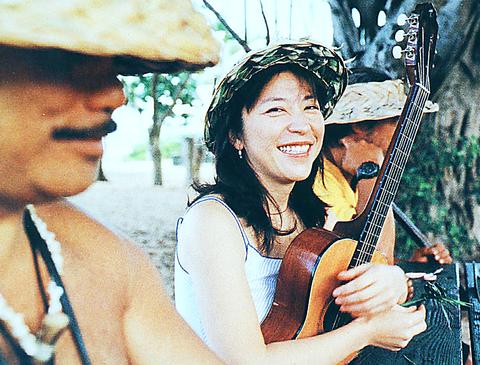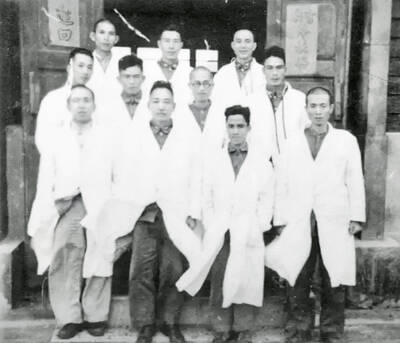When the late great Elvis Aaron Presley put the blue in Hawaii all those years ago he would have had no idea that one day a Brazilian-born Japanese woman would be bringing her own colorful brand of Blue Hawaii to Taiwan.
"Bossa Nova Hula: Lisa Ono's Blue Hawaii," the concert by singer/songwriter, violinist, acoustic guitar player, Lisa Ono, is set to have the auditorium of the Sun Yat Sen Memorial Hall swinging tonight, when the soulful-voiced jazz diva hits the stage as part of her summer tour. The concert is her only performance in Taiwan.
Born in Brazil to Japanese parents, Ono was introduced to the smoky jazz bar scene at a young age. While most of her peers were doing what normal 10 year-olds do, Ono was hanging out with her father at his popular Sao Paulo nightclub.

COURTESY OF EMI TAIWAN
After moving back to Japan, Ono's father opened the Saci Perer nightclub in Tokyo, where the teenage Ono began to perform a predominantly Brazilian repertoire of samba and bossa nova tunes. Now Ono performs many of her tunes in English and Japanese.
Dubbed the "Queen of Bossa Nova" in Japan, Ono has become one of the world's top practitioners of the mild and rhythmical form of Latin jazz.
Since debuting in 1989 with Catopili, an album on which the Sao Paulo native first began experimenting with her own style of samba and bossa nova, Ono has gone on to release 12 albums, the most successful of which being the 1999 jazz-influenced Dreams, a record which went on to sell over 200,000 copies worldwide.
Apart from selling over three million records since 1989, Ono has also been responsible for single-handedly shaping a bossa nova revival in Japan. Along the way she has collaborated with some of the biggest names in bossa nova and jazz, including "the pioneer of bossa nova" Antonio Carlos Jobim.
More recently, Ono teamed up with producer Eumir Deodato for her 2000 release, Pretty World. Deodato, who has worked with the likes of Roberta Flack, Aretha Franklin and Bjork, helped the performer add an original edge to the material on that album, which was a pot pourri of her own bossa nova interpretations of tunes by the likes of Stevie Wonder, Leon Russell and The Police. These fusions, while sounding at first rather odd have proven incredibly popular in her native Brazil, as well as in Japan.
For tonight's concert the queen of bossa nova will be performing a selection of tunes taken from her Pretty World album, which has only recently been released locally.
What: Lisa Ono Bossa Nova Hula: Lisa Ono's Blue Hawaii
When: Tonight
Where: Taipei's Dr Sun Yat Sen Memorial Hall (台北市國父紀念館), 505 Renai Rd., Sec. 4, Taipei (台北市仁愛路4段505號)
Tickets: Tickets cost between NT$900 and NT$2,500 and are available through ACER ticketing outlets or at the door.

A vaccine to fight dementia? It turns out there may already be one — shots that prevent painful shingles also appear to protect aging brains. A new study found shingles vaccination cut older adults’ risk of developing dementia over the next seven years by 20 percent. The research, published Wednesday in the journal Nature, is part of growing understanding about how many factors influence brain health as we age — and what we can do about it. “It’s a very robust finding,” said lead researcher Pascal Geldsetzer of Stanford University. And “women seem to benefit more,” important as they’re at higher risk of

March 31 to April 6 On May 13, 1950, National Taiwan University Hospital otolaryngologist Su You-peng (蘇友鵬) was summoned to the director’s office. He thought someone had complained about him practicing the violin at night, but when he entered the room, he knew something was terribly wrong. He saw several burly men who appeared to be government secret agents, and three other resident doctors: internist Hsu Chiang (許強), dermatologist Hu Pao-chen (胡寶珍) and ophthalmologist Hu Hsin-lin (胡鑫麟). They were handcuffed, herded onto two jeeps and taken to the Secrecy Bureau (保密局) for questioning. Su was still in his doctor’s robes at

Last week the Democratic Progressive Party (DPP) said that the budget cuts voted for by the China-aligned parties in the legislature, are intended to force the DPP to hike electricity rates. The public would then blame it for the rate hike. It’s fairly clear that the first part of that is correct. Slashing the budget of state-run Taiwan Power Co (Taipower, 台電) is a move intended to cause discontent with the DPP when electricity rates go up. Taipower’s debt, NT$422.9 billion (US$12.78 billion), is one of the numerous permanent crises created by the nation’s construction-industrial state and the developmentalist mentality it

Experts say that the devastating earthquake in Myanmar on Friday was likely the strongest to hit the country in decades, with disaster modeling suggesting thousands could be dead. Automatic assessments from the US Geological Survey (USGS) said the shallow 7.7-magnitude quake northwest of the central Myanmar city of Sagaing triggered a red alert for shaking-related fatalities and economic losses. “High casualties and extensive damage are probable and the disaster is likely widespread,” it said, locating the epicentre near the central Myanmar city of Mandalay, home to more than a million people. Myanmar’s ruling junta said on Saturday morning that the number killed had